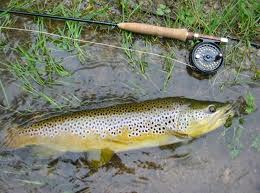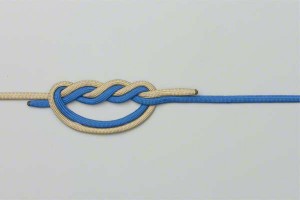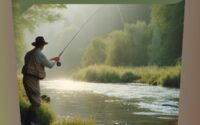| Disclosure: Just to be open and honest the buttons and links you click on in the website will in most cases take you to another website where you can purchase the products I am reviewing. As an Amazon Associate I earn from qualifying purchases. |
How to make a Fly Fishing Leader – Tips for the Beginner
How to make a fly fishing leader
When it comes to setting up your fly rod for fly fishing the last piece of the puzzle is how to make a fly fishing leader. As a beginner you will need to master this fairly well as you don’t want to lose caught fish due to poorly prepared leaders. Like all aspects of fly fishing it depends on the target species to what your leader will look like. As we have been on the process of learning how to trout fish we will stick to a leader for a 10ft rod of seven weight set up. How to make your own leaders for fly fishing and make them well will add to your enjoyment of the sport and get you out of difficult situations when you are having problems with your fly fishing leaders.
Generally speaking a trout leader setup is made from lighter material than the fly line. This is due to a couple of things, one we want to present our flies with a nice flutter down onto the water and not a splash and secondly we need to use something that the trout find hard to see.
 You may wonder how effective a trout’s eyes really are. I can tell you they have very keen eyesight and can spot a small dark fly in the dead of night. When fishing for sea trout the darker the night the better and those trout could pick up your fly when it was difficult to see your hand in front of your face. So to try to counteract this we need to decide on line diameter and color.
You may wonder how effective a trout’s eyes really are. I can tell you they have very keen eyesight and can spot a small dark fly in the dead of night. When fishing for sea trout the darker the night the better and those trout could pick up your fly when it was difficult to see your hand in front of your face. So to try to counteract this we need to decide on line diameter and color.
This again depends on the target fish. A trout of 1-2lbs can be caught effectively on 3-4lb mono whereas a trout of 6-8lb would need something around 5-8lb depending on how hard you want or need to play them. I say “need” as fishing catch and release requires that you get the fish to the net as quickly as possible and so releasing without completely exhausting it. Some species do not do well when exhausted and need longer times to gain their strength. Catch and release is another topic we shall cover in another post.
So we have matched our breaking strain to our target species. Next we need to try and match the water color. Mono is by far the cheapest material, it can have good success when matching color and kept small in diameter but fluorocarbon has been proven to be better. However this comes at a price as fluoro can be expensive depending on the brand. I tend to use both. If its wild brownies in a trout river who have a scarce food supply both will work as the trout is starving and should take most flies swimming past its nose. However in a river where there is ample food supply then the fluoro will provide better stealth to fool the trout into thinking your fly is food.
I mentioned color and this has to be taken into account. Not all water is the same color. It varies from brown through greens to blues to clear with many tones in between. If you can match the line color to the water you have a better chance of fooling the trout. As a beginner I would carry three spools of mono clear, green and brown. This should cover most situations.
To get good turn over on a fly cast a leader should ideally be tapered especially when trout fishing with dry flies or small wet flies. The tapered effect of the leader allows the fly to delicately fall down onto the water so minimize splash. If fishing with larger flies some tapering is useful but not really necessary as I would usually be fishing with these in large waters with good flow or in the sea.
It depends on the weight and size of fly along with the rod setup you are using. This is something to experiment with once you have mastered how to make your own leaders. You can make them whatever way you find they work for your particular way of fishing along with the targeted species. Fishing is so diverse now that what might work for me could be completely wrong for you. We have been talking about trout fishing and for this example we will continue to assume we are fishing the seven weight 10ft rod.
When starting out it is beneficial to not make the leader too long as this can cause a whole set of problems especially if there is a challenging wind. For this reason I would recommend a leader of approx 8-9ft. I would also suggest only trying with one fly but for this article we shall show you how to tie in a dropper so you can make up leaders of one, two or three flies. I have seen Scottish anglers on loughs with teams of 4-5 flies but I think this is just full hardly unless you are very skilled as one gust of cross wind and your leader will turn into a birds nest.
So the first thing to do is choose your leader material. There are a whole bundle of options but for simplicity and budget we will use basic clear monofilament of 8lb breaking strain. There are two main ways to make the leader. The first is to use one piece of mono and cut it into two pieces then join them to form the dropper. The other is to use one full length piece of mono and add a second short length to it to form the dropper.
I have to say when Salmon fishing I would always use the second method as it means there is no break in the main line so your led fly has minimal connections. The first method I would use for trout up to a certain size as it allows for making the dropper sit out at a right angle proud from the main line to aid in disguise. This is not so necessary with Salmon as they are not usually leader shy.
First method – Take your piece of leader material and runoff 9ft. Cut the material in two and tie two blood knots together leaving one tag end long say about 8 inches. When tightening make sure to wet the knots so not to burn the material and weaken it. Now you should have a dropper sitting proud of the main line and a tag end. trim the tag end close to the knot.
Second method – Take a piece of leader material again 8-9ft and take another piece about 12 inches. Form a three turn water knot with the two pieces of material around the middle of the long length. 4-5ft. Make sure again to moisten before tightening and trim the tag  end. To make the dropper sit perpendicular trim the lower tag end and to make it sit close to the main line trim the upper.
end. To make the dropper sit perpendicular trim the lower tag end and to make it sit close to the main line trim the upper.
Lastly you want to form a loop at the end of the leader. I use a three turn surgeon’s knot again as it never slips. To join the leader to your fly line you simply do the loop to loop connection making sure the loops are properly laid before tightening down. A wrongly formed loop to loop will cause it to hinge and can weaken the connection.
So there you have it a few things to look out for and how to make a basic leader. When you get more advanced you can slip in material of different diameter to form tapered leaders which will give better turnover of the flies.
Need more info on fly fishing check my review on fly fishing unleashed!
A great book with diagrams showing you how to tie the most common knots used in fishing. Every fisherman should have one! Get your copy here!




Very interesting. I have always wanted to try fly fishing but haven’t gotten around to it yet.
I’ve fished for bass and northern for years. What you said about fish eyesight is incredible. I had no idea they could see that well.
I am curious about something though. You mentioned that fish with an abundance of food are a little tougher to catch than those who do not. How can you tell if a river or trout stream has an ample food supply or not? Is there somewhere that I can go to find out more about that?
Hi Joe, if its a certain river you want to try then go to the local tackle hut closest to the venue and ask. If no-one around to ask then you will have to research it yourself.
You can do a bit of entomology on the river bank, get a fine mesh net and scrap away some of the bottom of the river bed and see what insect life you catch. You need to also check the surrounding vegetation for insect life all can be blow on to the water for the trout to feed on.
The more time you spend on a piece of water the more its life-cycle you will learn. Most seasoned fly anglers will know the optimum time or year, month, day etc to fish certain stretches because of certain aspects of insect life which make for interesting fly fishing when trying to match the hatch.
Another place to try would be fishing forums. Search for one in that area join up and ask who has fished that river ,most anglers will let you know the score.
Such a great article. I love fishing and my grandson is just 5 years old but sometimes I take him with me. But this is another level so we can make our own Fly Fishing Leader. Looking forward when he visits me again so we can try it and go for fishing. Thanks
Regards, Marty
Building your own fly fishing leaders can be fun as well as the actual fly fishing for you and your grandson. If you then go and catch fish on those leaders so much better the buzz.
I recommend practicing a bit before letting them loose on the water you don’t want to lose a fish to a weak knot.
This is really cool. I love going fishing because my Dad use to take me all the time as a kid.
Now that my son is old enough to learn the ropes of the salt life, I want to teach him everything I know.
I see that I am still learning since coming across this article because I never knew how to make a fly fishing leader.
Definitely trying this technique next time I go fishing then teach it to my son. Great article, very helpful.
Snap Garrett, my dad introduced me to fishing when I was about 4 years old. Fishing off the sea shore with a beachcaster. I wasn’t really fishing but just there along with him. It wasn’t until I was about 12 or so that he bought me my first fly rod and I never looked back from there.
It’s a great gift you can give your son one I am also bestowing upon my boys now. I can see the excitement on their faces when I suggest we get the rods and go to the lake, money can’t buy that.
Learning how to build a fly leader or even a shook leader for the sea is all about proper use of knots. Get the know correct and you will catch fish simple enough eh? It takes a bit of practice but learning a few knots well early on will stay with you on your lifetime of fishing and pull you out of many a awkward situation.
Tight Lines. (remember to moisten the material before tightening)
Hi Mark,
I just finished reading your awesome article on how to make a fly fishing leader and saved your website to my favorites. I have always been a saltwater fisherman since I was a kid growing up in the Florida Keys.
I now live in the Appalachian Mountains in North Carolina and want to give Fly Fishing a try.
Lucky for me, I have a very good friend who is a fly fishing instructor. I can’t wait for our first fishing trip. Thanks again for a great article Mark.
Happy fishing,
Jack
Great news to hear you are going to take up fly fishing. North Carolina looks to have some decent fly fishing and these guys have a decent website to check them out.
However having a buddy who is a fly fishing instructor is a bonus as he is going to know the best rivers and beats to try. Local knowledge is the best when it comes to trying a new river and you are sorted there.
He will also be able to help you get gear and how to set it up. However i would recommend not relying on him too much but trying things for yourself. I say this so you can learn the process for yourself. Already being a saltwater angler you are going to know how to tie knots etc but watercraft, casting and chasing trout is a lot different.
Tight Lines, would love to hear of your adventures.
Awesome article. I’m more of a tight line fisherman but I plan to go fly fishing for the first time next month and this article is perfect. I will use these methods to build a couple of my own leaders. I hope to use these methods to be successful in my first fly fishing outing.
Fly leader building is not that difficult and with a bit of practice and some care you can be an accomplished tier in no time at all.
The handy thing about making your own fly leaders is you can adjust them to suit any situation. Store bought ones don’t have that option and you may be fishing the wrong length when you need not be.
Tight Lines on your next adventure.
Great article. I had no idea trout could see so well but it makes sense. How else can they get the sustenance to support their weight. I never thought of getting leader that was different colors. Maybe that’s why I haven’t been that successful catching fish. I am always learning something new. Thank you for the information, I will put it to good use!
It’s amazing how well a trout can see even in the dark. They probably go a bit on other senses like the twitching of an insect will make a small ripple in the water column they probably feel too.
I know about learning new things it’s a life long journey I’m still finding out new things and I’m at this over thirty years. The color of the material can be very important and is relevant to the water you are fishing. If it’s dark and peaty then color may not be a problem but if clear then I would recommend trying out different types to see which don’t spook the fish so much.
Thanks for sharing this article. Been failing on catching one (no doubt I am one of the beginners mentioned here) and this article did share some good tips on setting the fly fishing rod correctly.
Though it require some steps to set it up correctly but the instruction here are clear enough. Am going to try this out this weekend and see if I could at least get one this time around.
I have tried to lay out the basics of building a fly leader is an easy to follow method. Although what I think is easy can be so awkward for others. When you go through it if you’re stuck give me a shout and I’ll try and help you out.
I’m sure if you follow the steps your leader will hold up and you will catch some fish this weekend.
If you’re building your own leaders you need a thick butt section, probably 15-20 pound test. Then work down by DIAMETER. Pound test has absolutely nothing to do with a tapered leader. You want to taper your leader down gently by keeping the diameter between sections close. Also it’s good to use mono to build the bulk of your leader but use Fluro for the tippet. You can search “leader building formulas” and it will tell you exactly what DIAMETER line to use
Hi Andy, yes agree when making a tapered leader to use your guide, in fact its a post I was planning to do soon, as this website is aimed at beginners I have written this post on how to build a basic leader using the same diameter material.
I know using different diameter materials help with the turnover and over all presentation but the basic leader is what I used for years as a kid when new to the sport, I didn’t get into tapered leaders until much later.
I thank you all the same for your comment and will get that post done soon. Question what material do you prefer when making your own leaders?
Thank you Mark, very useful.
I will have a bash at this next time out.
Alan
Hey Alan, all you need to do is practice, try it a few times at home with a bit of leader material, build it over and over till you are happy with your efforts. Most importantly moisten your knot before pulling tight. There is nothing worse than fiddling on the bank side unable to complete the leader when the trout are biting. Here is a few videos of some important knots to learn also.
Sure is nice to get all those ideas on how to build a leader! Anybody listen to the question?
HOW DO YOU BUILD A LEADER?
I haven’t fished since I was a young child. All we had were night crawlers and earthworms. We also used to use bread and managed to catch fish with those! LOL
Bait fishing if ideal for children it gets them into the sport and then they can progress into something more challenging like fly fishing.
I learned something new! I did not know that trout can see so well in the dark. I did know about matching the leader color to the water color, though. The Rio Grande River is not too far, i wonder how it fishes…. Be back soon
Its amazing what they can see, I have fished for sea trout on a black night and caught them on really small flies when I couldn’t see my hand in front of my face. A marvel of nature. Good luck on the Rio!
I have the gear, I just need to get back into fly fishing. We have a local (private) trout club that I have been invited to join. I just might do that
You have to do it John the time away from the walleye and the big lake will be breath of fresh air for you. When you catch your first trout you will be hooked.:-)
That three turn water knot is beautiful. There’s much detail to consider for fly fishing.
Hi Lisa, it is and really simple to tie, works a treat and is really strong.
Thanks Mark, this is great information for a noobie. Especially since I am on the opposite side of the continent from my buddy who introduced me to fly fishing and was teaching me this stuff. I was not aware of the distinction in leader shyness of trout and salmon. Good to know since we have both in the river I live on.
Yes Jim, Salmon on a whole are not leader shy especially when the water is right and they are running. However it may be more prudent to lower the leader thickness when summer fishing for salmon when the river is low. Usually a dry fly on a fine leader will produce results when normal tactics come up short. Thanks for reading and if there is anything else you need to know give us a shout. Even if you would like an article on a particular subject if i can help in any way I will do my best.
Thanks Mark, I am more interested in the trout as I want to fish for food. The salmon has been restocked and at present populations is only hook and release. I believe the trout are a real challenge to, but most people I have seen with no luck aren’t using flies. Maybe that is the ticket.
There is not a trout on the planet that can’t be teased by a fly. Try asking around or checking at your local tackle shop what patterns are being used or have been tried and don’t stick to that, look at the natural insects, watch the trout feed and see what is happening. Learn from nature Jim and you will be amazed at how easy it can become. I will do a bit of research for you as to patterns and techniques that work in NS but local knowledge is best.